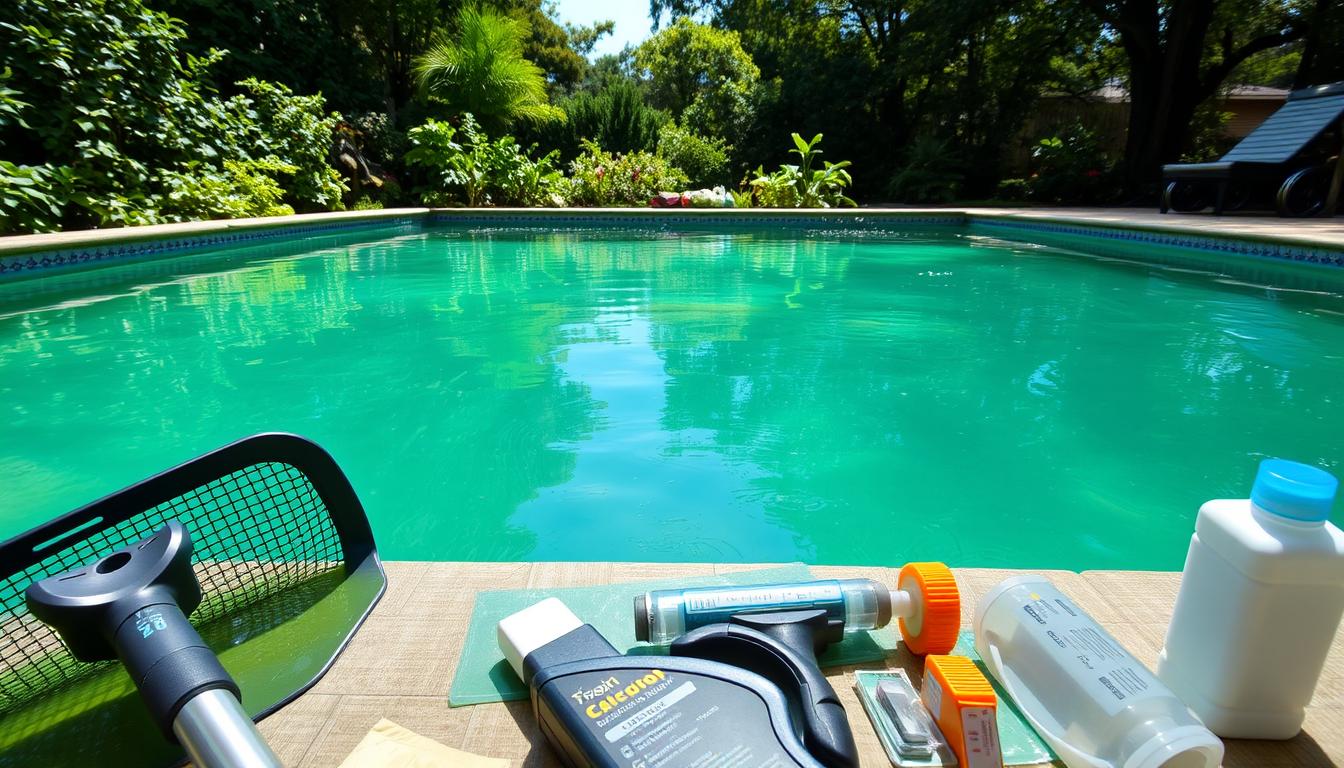
Seeing your once-clear pool turn into a green mess can be disheartening. But don’t worry! Cleaning a green pool isn’t as hard as it looks. With the right approach, you can restore your pool’s sparkle quickly.
Algae growth often causes green pools when chlorine levels drop too low. Proper maintenance is key to prevention. However, life can get busy, and suddenly you’re facing a green pool.
We’re here to help you tackle this issue head-on. Let’s explore how to clean your green pool effectively. We’ll cover causes, removal techniques, and maintenance tips for a crystal-clear pool.
Key Takeaways
- Maintain proper chlorine levels between 2.0 and 4.0 ppm to prevent algae growth
- Balance pool chemistry, especially pH levels, before treating for algae
- Brush and vacuum the pool to break up algae and remove debris
- Use a pool shock with around 70% available chlorine for tough algae and bacteria
- Run the filter continuously and clean filter elements during the cleaning process
- Re-test and balance water chemistry after treatment for optimal pool health
Identifying the Cause of Green Pool Water
Green pool water can be unsightly and potentially unhealthy. Algae growth, imbalanced pool chemistry, and poor circulation are common culprits. Understanding these factors helps restore pool clarity and ensure safe swimming.
Algae Growth and Its Types
Algae are microscopic plants that thrive in aquatic environments. They grow in sunlight, warm temperatures, and nutrient-rich water. Different types of algae can infest pools.
Here are some common algae types:
| Type of Algae | Characteristics |
|---|---|
| Green Algae | Most common type, floats freely in water, gives pool a green tint |
| Black Algae | Appears as dark spots on pool surfaces, difficult to remove |
| Mustard or Yellow Algae | Grows in shaded areas, brushes off easily |
| Pink Algae | Rare type, appears as slimy pink deposits |
Imbalanced Pool Chemistry
Proper pool chemistry prevents algae growth and ensures water clarity. Imbalanced water can make swimming uncomfortable and damage pool surfaces. Key levels to maintain are:
- Total Alkalinity: 80 – 120 ppm
- pH: 7.2 – 7.8
- Total Hardness: 200 – 400 ppm
Low chlorine levels can lead to algae growth and green water. High pH reduces chlorine’s effectiveness, creating an ideal environment for algae. Regular testing and adjusting help maintain a healthy pool.
Poor Circulation and Filtration
Efficient circulation and filtration are vital for a clean pool. Malfunctioning systems or insufficient pump time can cause green water. Clean filters regularly based on their type:
- Cartridge filters: Clean every 2 to 6 weeks
- DE filters: Backwash every 1 to 3 months
- Sand filters: Backwash every 1 to 4 weeks
Run the pool filter for at least 8 hours after shocking. This helps remove impurities and restore clarity. Good circulation ensures treated water reaches all pool areas, eliminating algae and contaminants.
How to Clean a Green Swimming Pool
A green pool can be challenging to clean. But with the right tools and approach, you can make it pristine again. This process involves several steps to eliminate algae and restore water quality.
Test and Balance Water Chemistry
Start by testing your pool water. Adjust the pH and alkalinity levels using specific chemicals. Proper water balance helps chlorine and other treatments work effectively.
Aim for a pH range of 7.2 to 7.6. Keep total alkalinity between 80 and 120 ppm. This balance is crucial for eliminating algae and bacteria.
Brush and Vacuum the Pool
Brush all surfaces of your pool thoroughly. This dislodges algae and debris, preventing further growth. After brushing, vacuum the pool to remove the loosened material.
Apply Chlorine Shock Treatment
Shock the pool by super chlorinating it. This step is vital for killing algae and bacteria. The amount of chlorine needed depends on the severity of the problem.
Follow the manufacturer’s instructions for proper dosage. You may need to add multiple gallons of liquid chlorine over several days.
Add Algaecide
After shocking, add an algaecide to kill remaining algae. This also prevents future growth. Follow the product label for the right dosage based on your pool size.
Run the Filter Continuously
Run your pool’s filtration system for 24 to 48 hours. This removes dead algae and debris. Be prepared to backwash your filter 3 or 4 times daily.
A D.E. filter clears a green pool faster than a sand filter. However, it requires more maintenance.
| Filter Type | Clearing Time | Maintenance |
|---|---|---|
| D.E. Filter | 2-3 days | More frequent backwashing |
| Sand Filter | 4-5 days | Less frequent backwashing |
Clean Filter Elements
Inspect and clean the pool’s filter elements regularly. Clogged filters can slow down the cleaning process. If your filter doesn’t clear the pool within 5 days, seek professional help.
Re-test and Balance the Water
After treatment, re-test your pool water. Adjust the chemistry as needed to maintain balance. Regular testing prevents future algae growth and keeps your pool safe for swimming.
Clearing a green pool takes time and effort. Stick to these steps and maintain a consistent cleaning routine. Soon, you’ll have a sparkling, inviting pool again.
Conclusion
Keeping a pool clean and healthy requires constant effort. By following these steps, you can turn a green pool crystal-clear. Regular maintenance is crucial to prevent algae and ensure safe swimming.
Adopt a routine that includes brushing, vacuuming, and emptying skimmer baskets. Test and balance water chemistry regularly. Use a quality algaecide as directed to reduce algae growth.
Run the pump and filter for 8-12 hours daily. This ensures proper circulation and filtration. It maintains water clarity and prevents contaminant buildup.
Shock the pool regularly to eliminate bacteria and algae spores. Do this after heavy use, rainstorms, or temperature changes. Cover the pool when not in use to reduce sunlight exposure.
Stay proactive with these maintenance tips. This will significantly reduce algae growth. You’ll enjoy a healthy, inviting pool all season long.







